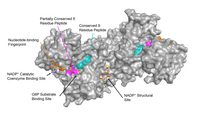
Photo from wikipedia
Anemia affects people worldwide and results in increased morbidity and mortality, particularly in children and reproductive-age women. Anemia is caused by an imbalance between red blood cell (RBC) loss and… Click to show full abstract
Anemia affects people worldwide and results in increased morbidity and mortality, particularly in children and reproductive-age women. Anemia is caused by an imbalance between red blood cell (RBC) loss and production (erythropoiesis), which can be caused by not only nutritional factors but also non-nutritional factors, such as inflammation and genetics. Understanding the complex and varied etiology of anemia is crucial for developing effective interventions and monitoring anemia control programs. This review focusses on two interrelated nonnutritional causes of anemia: malaria infection and RBC disorders (thalassemia and G6PD deficiency), as well as tuberculosis. According to the Haldane hypothesis, thalassemia occurs as a protective trait toward malaria infection, whereas G6PDd arises in malaria-endemic regions because of positive selection. Indonesia is a malariaendemic region; thus, the frequency of thalassemia and G6PD deficiency is high, which contributes to a greater risk for non-nutritional anemia. As Indonesia is the second global contributor to the newly diagnosed tuberculosis, and active pulmonary tuberculosis patients are more anemic, tuberculosis is also contributes to the increasing risk of anemia. Therefore, to reduce anemia rates in Indonesia, authorities must consider non-nutritional causes that might influence the local incidence of anemia, and apply co-management of endemic infectious disease such as malaria and tuberculosis, and of genetic disease i.e. thalassemia and G6PDd.
Journal Title: Asia Pacific journal of clinical nutrition
Year Published: 2020
Link to full text (if available)
Share on Social Media: Sign Up to like & get
recommendations!